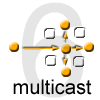FAQ : Connectivity (Tunnels and Subnets) : Multicast Support
Multicast Support
Which PoPs support Multicast?
When support on the PoP is currently provided it currently mentions 'ecmh' on the PoP overview or the PoPs information page. m6bone and the 'ecmh cloud'For SixXS there are two multicast 'domains': the m6bone and the 'ecmh cloud'. m6bone is the international IPv6 multicast backbone where a lot of networks are connected to. with the 'ecmh cloud' we mean all the networks that are connected to eachother using ecmh. The m6bone cloud is receive only for networks in the ecmh cloud, but every host inside the ecmh cloud can both send and receive any multicast group. m6bone is send and receive for PoPs that are directly connected to the m6bone. Some PoPs are also realizing direct connectivity to the m6bone which is the experimental Multicast IPv6 network which also gives access to various multicast streams and also the IPv4 to IPv6 multicast service. To see which PoPs support Multicast check the PoP Status Overview. What is 'ecmh'?Easy Cast du Multi Hub (ecmh) is basically a MLDv1 and MLDv2, including Source Specific Multicast (SSM), supporting multicast IPv6 router which is implemented in userspace. Using the MLDv1/2 protocol it maintains a list of source and destination combinations that have requested traffic destined for a IPv6 multicast address and forwards it when such a combination exists. Effectively 'ecmh' acts just like every other IPv6-multicast enabled computer, except when it sees a 'subscribe' request on one interface, it automatically forwards this request to its other interface. This way al the interfaces connected to a host running an ecmh can 'share' their multicast subscriptions. Additionally when a host sends a multicast packet, ecmh picks this up and forwards it to the interfaces that are subscribed to the group where that packet is destined for. This allows full send/receive multicast. Users can install ecmh on their own routers and allow them to participate in the Multicast network allowing their hosts to receive Multicast by letting them subscribe to it. How to enable your subnet to do MulticastIf you want to enable multicast in your subnet, then you first need to check if your PoP supports this. When this is the case, you need to install ecmh on the host that terminates your tunnel and effectively all routers in between your host and the PoP. Note that nodes in the ecmh cloud speak to eachother with MLDv1/v2 messsages, as such, any other protocol should not be used, eg PIMv6 is useless as the upstreams don't understand this protocol. Checking connectivityOne can check connectivity by setting up a dbeacon on your machine. When you have dbeacon running on the same host as ecmh, do configure the 'interface' attribute correctly so that it sends its outbound packets over the upstream interface (generally your tunnel to the PoP). This as ecmh doesn't currently forward locally generated packets to the other interfaces. An example dbeacon.conf: name: YourName contact: you@example.org addr: ff1e::1:f00d:beac website: http://example.org matrix: http://dbeacon.example.org CC: EU ssmping: false interface: sixxs dump: /www/dbeacon.example.org/dump.xml interval: 30 Note that interface, we select there the interface that goes to the PoP, this as only 1 interface is used for sending the message and thus the beacon message goes up only once. Operating System Notes
On Windows XP don't forget to disable the firewall using: On some WRT and WRT-alike platforms, be aware that when the it is configured to be a bridge, that IPv6 multicast packets are not properly forwarded. |